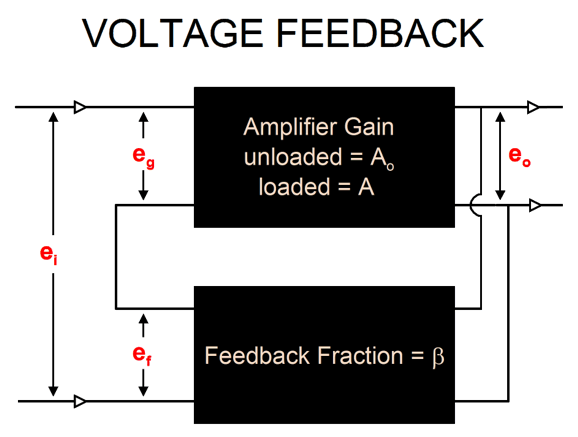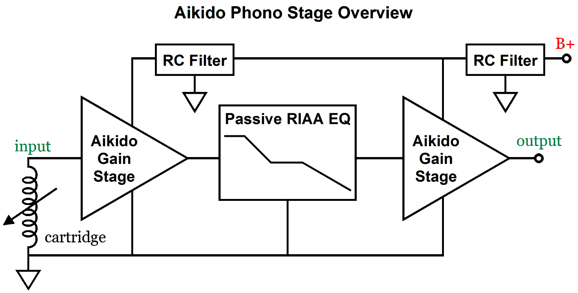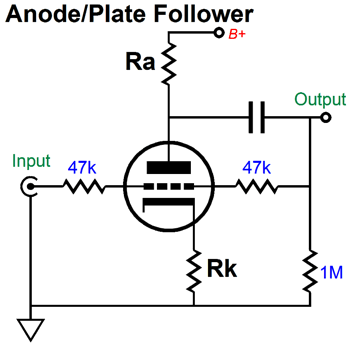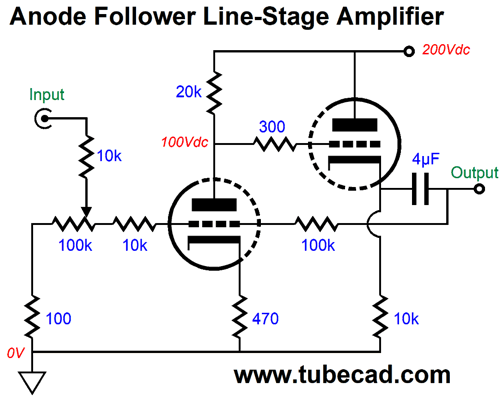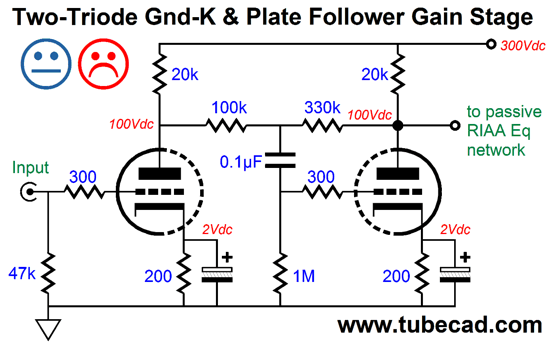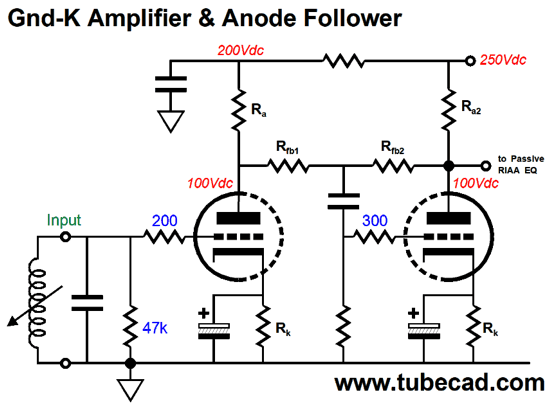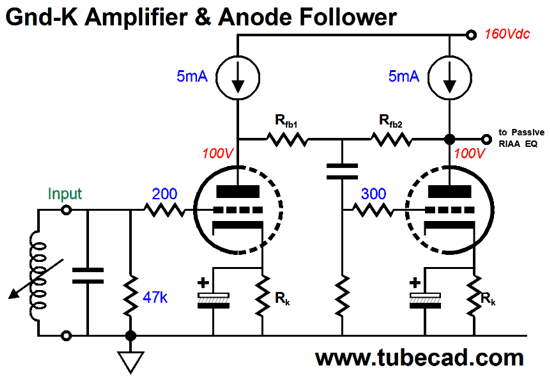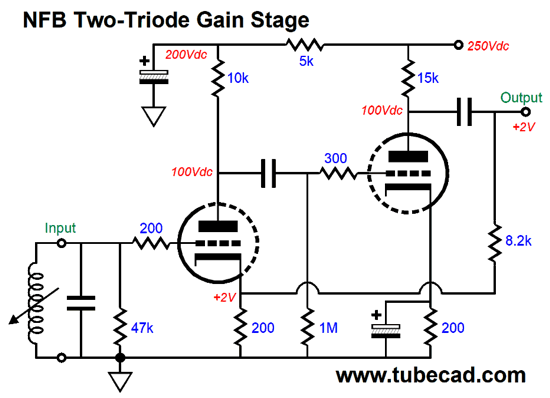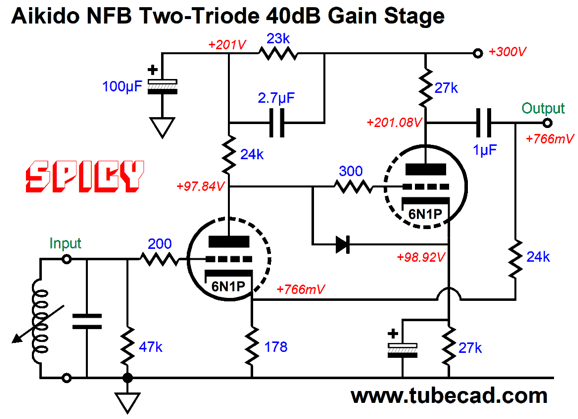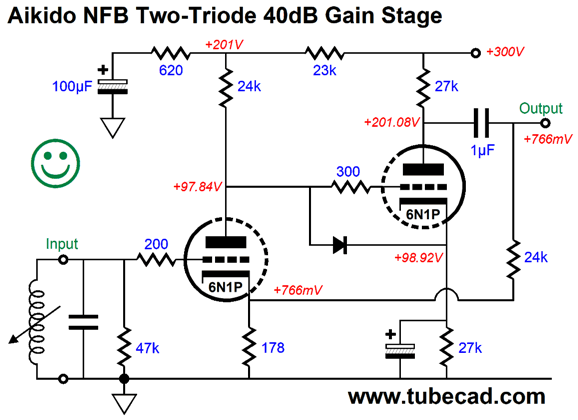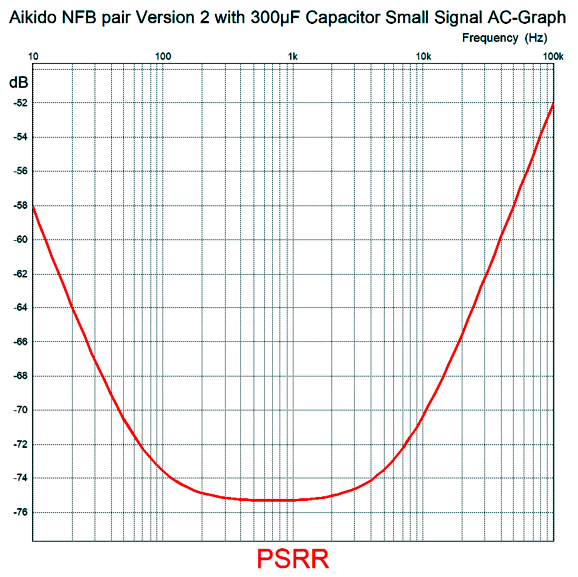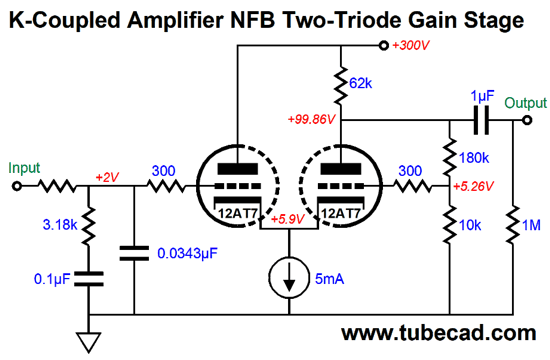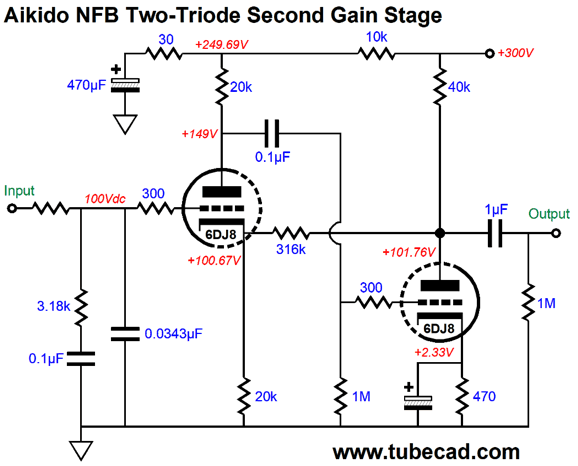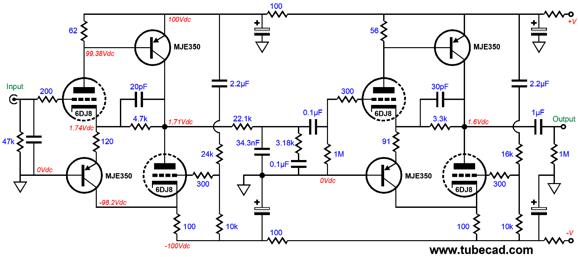| John Broskie's Guide to Tube Circuit Analysis & Design |
|
22 May 2018 Post 425
Two-Triode NFB Stages
The Tetra phono preamp uses two CCDA gain stages, while the PH-2 uses two Aikido gain stages—both circuits offer relatively high gain and low output impedance, with the Aikido gain stage offering great a PSRR as well. On the other hand, we could use two negative-feedback-based gain stages instead, with the same passive RIAA EQ network in between. In other words, we could still use negative feedback, but only to clean up the two gain stages, not to equalize the needed RIAA equalization. Last time, I showed a few possibilities, each with the stipulation that no more than two triodes would be used per gain stage. After going over my last post, I realized that I had jumped ahead too much, as I left out a half-and-half arrangement. Applying a negative feedback with two triodes allows either a complete loop or just a partial loop. The partial-loop approach makes use of the anode-follower (aka, plate-follower) circuit.
The anode-follower/plate-follower circuit is no stranger to my posts, starting back in the year 1999, then in blog 105, then in blog 315, and last in post 336. (There might be more that I missed.) By the way, my first tube-based line-stage amplifier was an SRPP, which built almost 40 years ago. I soon replaced it, however, with the following anode-follower design.
The tube design was mine, but I lifted the idea from an OpAmp circuit. I disliked stereo audio-taper potentiometers, as they didn't track well between channels. In contrast, high-quality dual plastic-film potentiometers could be bought that did track each other supremely well, and which the circuit above used. In addition, I liked that the feedback ratio increased as the volume control went down. In other words, as I turned down the volume, I also decreased the amount of noise and distortion from the line stage. (I do not actually remember the exact values that I used, but these are probably close enough.) Now, if we cascade a grounded-cathode amplifier into an anode follower, the first triode runs negative feedback free, but the second triode is enclosed within a negative feedback loop. This arrangement allows us to fine tune the final gain. For example, if we desire a final gain of 100, but the input stage triode only yields a gain of 20, then we can set the anode follower's gain to 5, allowing us to attain the goal of 100. Think of the anode follower as being a like an inverting cathode follower that can deliver gain. Of course, the higher the gain we get, the higher the output impedance; conversely, the lower the gain, the lower output impedance. Remember that it is the triode's open-loop gain that powers the negative feedback. Here is an example from post 336.
The circuit earned an unhappy face due to its poor PSRR. One easy workaround is to give the first stage an RC filter, so at least its output is relatively noise free; and we rely on the negative feedback loop to clean up the anode-follower's output.
Another approach, a better approach in my view, would be to replace the plate resistors with constant-current sources.
Not only do we vastly improve the PSRR, we gain more gain and we can use a much lower B+ voltage. Indeed, we could even drop the B+ (in the circuit above) to 125Vdc and not worry about wall voltage variations and aging tubes. Effectively the input triode's plate load resistor is resistor Rf1, which can be quite large in value, yet displaces no B+ voltage. In addition, we do not need big output voltage swings. Remember, in the first stage of a phono preamp, we only need a gain of 30dB or 40dB, which against a 1mV signal only comes to 0.1V of output with 40dB of gain. Having got this partial possibility out of the way, we can move on to full, global negative-feedback circuits. Here is an example from my last post.
Now, let's look at my Aikido version of this circuit, but with a different tube and with a gain of 100 (+40dB).
Adding the 2.7µF capacitor that shunts the 23k RC resistor and injects a small portion of the power-supply noise—purposely. This fraction of the power-supply noise is enough to force a noise null at the output. In SPICE simulations, this technique works beautifully; in reality, however, expect problems as the 100µF electrolytic capacitor will probably be off by at least 10%. On the other hand, if you use a 100µF film capacitor, this setup will work in reality as well as it works in SPICE. Still, it's a pain. I much prefer to use 1% resistors, which are cheap and plentiful, rather than capacitors to do AC divider work. Well, there is a workaround, which I first showed back in 1999. (I won't show the original schematic, as it is too embarrassing.)
Instead of an added capacitor, we have an added resistor. Now the 100µF capacitor can be off by 50% and we will still enjoy a fine PSRR. Actually, I just ran further SPICE simulations and I found that, in this example, the 100µF capacitor should be replaced by a 300µF capacitor to get the best power-supply-noise null at low frequencies. What if the 620-ohm resistor is off? Easy. We replace it with a 604-ohm or 634-ohm resistor. As I pointed out earlier, resistors are cheap. Here is the SPICE-generated PSRR versus frequency graph.
Here in The States and Canada, we want the null to extend down to 120Hz, as that is the ripple frequency of a full-wave-rectified power supply. By the way, do not worry too much about the high frequency rise, as a simple RC filter on the B+ rail, after the second triode, will flatten it down. For example, adding an RC filter made up of a 100-ohm resistor and a 0.027µF capacitor was enough to bring 100kHz down to the -75dB mark.
Second Gain Stages
The circuit above is a cathode-coupled amplifier. The +2V of DC input voltage actually helps us by giving us a higher cathode voltage, which allows us to both use a solid-state constant-current source and a DC negative feedback loop. Note that the two triodes see dissimilar cathode-to-plate voltages, which is normally a hassle to deal with, but not in this setup. If the first stage's output DC voltage is something quite a bit higher, say 100Vdc, say from the anode-follower circuit shown before, then the following circuit might work best.
This is a simple two-stage, feedback pair, but with a twist. Note the DC coupling of the negative feedback resistor (316k). No coupling capacitor was needed, as the first triode's cathode voltage matched the second triode's plate voltage.
Once again, we see some of my Aikido mojo in the form of the added 30-ohm resistor. Without this resistor, the PSRR is -30dB; with it, -55dB. Truly, 99.99% of tube gurus would never dream of adding this resistor, which explains why you are reading this post.
Bipolar Hybrid NFB Phono Preamp
This design uses a bipolar power supply and sticks to the two-triode rule. Each gain stage employs a negative feedback loop. What is striking about this design is that I didn't bring the feedback to the bottom MJE350 PNP transistor bases. Effectively, each gain stage is a hybrid OpAmp. The bottom triodes are driven at their cathodes and their grids see some Aikido mojo, as a portion of power-supply noise is injected to create a noise null at the output. In greater detail: as the input triode draws more current, the increased current will flow through its 120-ohm cathode resistor and then through the MJE350 PNP transistor and terminate into the second triode's 100-ohm cathode resistor, causing a bigger voltage drop to develop across the resistor, which in turn will force the second triode to draw less current, which will cause its plate voltage to rise. At the top of the input triode, the 62-ohm cathode resistor will see the increase current flow and it, too, will develop a bigger voltage drop, which will cause the top MJE50 to draw more current, which will pull the gain stage's output up. The feedback loop then limits the output voltage swing to the preset gain ratio.
Music Recommendations, Odd Ones
Here is a snippet of praise that I found duplicated in many places on the web, but with no attribution; possibly it was NPR—or more likely, the BBC, note the spelling of humor.
"twisted touch of humour, hubris and quiet horror," there's something to put on your résumé. I listen to her sing and I have no idea which voice is really hers, which is her natural singing voice, and not just a persona she put on for the song. Follow this link to her videos and see if you can discern her natural personality. Still, I like her a great deal and her two CDs are available at Tidal. Try them, and you, too, might like them as much as I do. (Audiophile grade recordings, but the way.) The second singer I am recommending is English-born singer (she moved to America when he was ten), composer, and visual artist Anohni (f.k.a. Antony) of the band Antony and the Johnsons. (That is not a picture of her, by the way; it is a photograph of butoh dancer Kazuo Ohno, by Naoya Ikegami.) I am at a loss to describe her [transgender-transsexual] voice. How about this: imagine if Tiny Tim had a son/daughter who could really sing. And Anohni can sing and compose; her songs are not fluffy lightweight I-am-so-happy or I-am-so-unhappy songs. Here is a song title and song from her that you are not likely to forget, Her Eyes Are Underneath the Ground or Epilepsy Is Dancing. Sadly, my fear is that most won't give her a fair listen and I predict that her songs, much like those composed by the late Leonard Cohen, will become famous by being covered by others. Still, she can count me as a fan. The last singer Micah P. Hinson from Abilene, Texas.
His album, The Holy Strangers, is what he labels a "modern folk opera." Okay, but surely it's a gothic, haunting, macabre, modern folk opera. About 40 years ago, I heard the story of the French student who, long ago, was taking his final ethics exam, which held one question: What is courage? His answer: ç'est sa. Which means "this is" and after writing it he turned in his final. Okay, what grade would you give him? As I see it, only two possibilities exist: an F or an A. Would a grade like a B- or B+ make any sense? In the story I heard, the student got the A. (Google was surprisingly not that helpful. The best I could find was this article in the UK Telegraph.) Well, much the same applies to The Holy Strangers, as it either deserves an F or an A. I give it an unreserved A. Indeed, I would go so far as to call it my favorite album of the last ten years. Amazingly good, if not truly great. Listen to first, then read the review at DrowedInSound.com. Here is a portion of that review:
By the way, all the albums I recommended are available at Tidal—at least they were last time I looked. Like Netflix, Tidal does drop albums as it gains others. Check them all out before they are gone.
//JRB
User Guides for GlassWare Software
For those of you who still have old computers running Windows XP (32-bit) or any other Windows 32-bit OS, I have setup the download availability of my old old standards: Tube CAD, SE Amp CAD, and Audio Gadgets. The downloads are at the GlassWare-Yahoo store and the price is only $9.95 for each program. http://glass-ware.stores.yahoo.net/adsoffromgla.html So many have asked that I had to do it. WARNING: THESE THREE PROGRAMS WILL NOT RUN UNDER VISTA 64-Bit or WINDOWS 7 & 8 or any other 64-bit OS. I do plan on remaking all of these programs into 64-bit versions, but it will be a huge ordeal, as programming requires vast chunks of noise-free time, something very rare with children running about. Ideally, I would love to come out with versions that run on iPads and Android-OS tablets.
//JRB
|
|
John Gives
Special Thanks to the Special 68
I am truly stunned and appreciative of their support. In addition I want to thank
All of your support makes a big difference. I would love to arrive at the point where creating my posts was my top priority of the day, not something that I have to steal time from other obligations to do. The more support I get, the higher up these posts move up in deserving attention. Only those who have produced a technical white paper or written an article on electronics know just how much time and effort is required to produce one of my posts, as novel circuits must be created, SPICE simulations must be run, schematics must be drawn, and thousands of words must be written. If you have been reading my posts, you know that my lifetime goal is reaching post number one thousand. I have 575 more to go. My second goal is to gather 1,000 patrons. I have 932 patrons to go. Help me get there.
Only $12.95 TCJ My-Stock DB
Version 2 Improvements *User definable Download for www.glass-ware.com |
||
| www.tubecad.com Copyright © 1999-2018 GlassWare All Rights Reserved |
